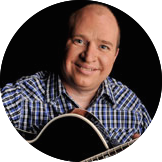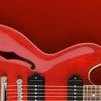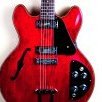
Triple-o
Members-
Posts
538 -
Joined
-
Last visited
-
Days Won
29
Content Type
Profiles
Forums
Gallery
Events
Articles
Blogs
Downloads
Everything posted by Triple-o
-
Thanks for posting. Larrivee, there’s a guitar name I hadn’t heard of before.
-
Correct. Its an interesting " Key" better know has the mixolydian mode. Its a good option when playing the blues.
-
You know the major keys C,D,G, etc. What is the Dominant Key? “Music that modulates often goes to this key”.
-
Some consider it a cheap trick because it can be used to repeat the last chorus without writing anything new. https://music.tutsplus.com/tutorials/how-and-why-to-modulate-to-new-keys--audio-23025
-
https://www.youtube.com/watch?v=jsufe8TjlBY
-
Paul Davids talks about them. I came across them in a free Artist Works jazz lesson on minor 9 arpeggios. Needless to say I was in a "brain fog" for few minutes. https://www.youtube.com/watch?v=36qTU4hScco
-
https://www.youtube.com/watch?v=KupVyVWUrzA https://www.musicnotes.com/sheetmusic/mtd.asp?ppn=MN0097770
-
She had many fans and probably was the favorite castaway. The theme song chord changes look like they can be a challenge. https://www.youtube.com/watch?v=x4g4HaRIYMY
-
“A jazz musician is a juggler who uses harmonies instead of oranges”. Session 18 I recently started to spend more time trying to understand just some simple jazz. Now that quote makes a lot more sense. Before I let chords like F13 ,Bbmaj13, Fm7 (jazz version) and A9 scare me away.Now I realize how much jazz as to offer and how it can help one utilize the fret board by juggling scales, arpeggios and chord shapes using simple jazz Standards.
- 1 reply
-
- 1
-

-
A while back I was watching a movie and they mentioned quavers and I hadn't a clue what they were talking about. https://www.youtube.com/watch?v=qi6uuhU1unk
-
I looked at the tempo for this song and assumed it was a really slow song. Then I noticed the 6/8 time signature. https://www.youtube.com/watch?v=IBLruNfUqUs https://www.musicnotes.com/sheetmusic/mtd.asp?ppn=MN0158019
-
Guitar legend Tony Rice dies on Christmas Day. Progressive Bluegrass (newgrass). One of his songs was “Gasology” I wonder if that was his answer to “Classical Gas”?
-
Well, TRIVIA is perhaps not the correct word. What famous guitar player has a Ph.D in astrophysics? nairb yam tsiratiug rof neenq
-
I came across this "short cut" while viewing the sound track music for La Bamba. They look a lot like tremolo marks. https://jennifercluff.blogspot.com/2009/05/slashes-through-note-stems.html
-
I know that Steve has this song in his course in the key of A. Here's a version in C that might be of interest to beginners. https://www.musicnotes.com/sheetmusic/mtd.asp?ppn=MN0099358
- 1 reply
-
- 1
-

-
I guess I never really understood the impact the Beatles had in South America. https://www.youtube.com/watch?v=BfVpvrYf_Lo
-
Shifting Pentatonic Scale Boxes Up/Down a Fourth/Fifth on Fretboard
Triple-o replied to Scott Jackson's topic in Music Theory
Thanks for posting, very informative. The major scales, like C for example has three major pentatonic beginnings C F and G and three minor pentatonic beginnings A D and E. ( l lV V ) When someone is playing a 12 bar blues over a l lV V chord progression using the relative minor scale in the key of C and using the 5 pentatonic patterns, they would use this knowledge quite a bit. When playing the Am pentatonic and using the subdominat F (lV) it really doesn’t need to be resolved. It would also make a good passing tone. It could also be a leading tone going from Am to Dm e F g.....D Something along the same line, when you are playing a minor pentatonic and you go down 3 frets you are in the 5th position of the parallel major pentatonic scale. Which also can be used to change things up while playing the minor pentatonic scale. Reminds me of the saying “there are no wrong notes just wrong choices. https://www.musicnotes.com/sheetmusic/mtd.asp?ppn=MN0112209 https://www.musicnotes.com/sheetmusic/mtd.asp?ppn=MN0074448 https://www.youtube.com/watch?v=Vn7as_o3pIA -
How to build a realistic practice routine?
Triple-o replied to randomguy's topic in Guitar Open Talk
Mohammed, Diane has given you a lot of good information. I thought I would share with you my current practice lesson 1. Hand stretching exercise. (I do this while preparing my morning coffee and usually under warm/hot water.) 2. 15 minutes work on scales,modes and arpeggios, those needed for my core material.I use a timer. for all my practice, if I take a break I stop the timer. Once I learn the material I will use a metronome to improve, it’s not my favorite tool and if I don’t have a fairly good “handle” on what I am playing the metronome doesn’t help. 3. 15 to 30 minutes on my “Core Material”. This practice period my core Material is Autumn leaves melody 5 th position, (jazz standards) Sundance, 5th position. (Mel bay) 12 bar blues solo 5th position, (activemelody on-line) This particular practice routine can last months.(I usually work on more than one thing to keep my sessions interesting and to avoid fretting hand fatigue. 4. 15 minutes chord melody chords for Autumn Leaves, barre chords and other chords used in the 12 bar blues solo sheet music. 5, 15 minutes working on a solo for Autumn Leaves. I am using scales and arpeggios I worked on in the first fifteen minutes of practice.plus, I also searched the internet for material for Autumn leaves done by better players and found two etudes and one solo to help me create my own solo. 6. Have a lesson plan with all the material organized. so you aren’t wasting time looking for chords or patterns. Have a major scale worksheet and a fretboard worksheet. I keep all the material in a folder. 7. in the evening I usually spend a little time reading music theory pertaining to my lesson and listening to the song I am trying to learn. Beginners have it easy. The material is already prepared in their guitar course. A private teacher will also have lesson plans ready to go. My “Guitar Goal” is learning to play the blues, “ if you sound good, you're probably not practicing.” unknown -
Corvid 19 claims another life. Charl was his given name, but due to a clerical error Charley became his legal name. It must have been a real shocker for 10,000 folks in 1966 when he walked out on stage. They had no idea what he looked like. I think you probably could have heard a "pin drop" at the "Old Red Barn Stadium". Guitarist and professional baseball player, he will be missed.
-
Mandy, I am saddened to hear of your loss.
-
Struggling to find good pentatonics sources, is it just me??
Triple-o replied to filipmo's topic in Guitar Open Talk
I learned the pentatonic scales and patterns from the “Learn and Master Guitar course” which is “neatly served “. Sounds like you’ve searched a lot of on-line guitar sites and couldn’t fine anything that you liked. Did you come across the guitar site ActiveMelody? How about GOSK.com for basic info about pentatonic scales. You might consider the books “Connecting Pentatonic Patterns” and “Soloing Strategies for Guitar” by Tom Kolb. Other books on chord tone soloing / soloing with arpeggios might also be useful, if your not already familiar with those topics. And if you have been playing for at least a year and know the major scales and can read music you might check out the “Basic Improvisation” class at Berklee on -line It’s expensive,but viewing their syllabus might help identify musical topics you need to better understand improvisation. Most beginners start their “Improv” journey on the shoulders of skilled players, seeing and listening and copying what better players are playing. One can also use books like “12 bar Blues solos” and “Solo Jazz standards” to help learn. Steve also has a jazz standards course you could check out,since improv is a major part of jazz. -
I am currently reading a book on arpeggios by Stephan Ross.In the book he says "the ability to move around the neck fluently through all of the arpeggios forms provides greater creative freedom and leads to more interesting lines". It also said to use what you know, so he wouldn't be concerned about you using two scale shapes. In the book he is using the 5 pentatonic patterns. It is a beginner book, so I assume he is trying to keep it simple and not over whelming. One of my books listed about 35 shapes and the caged system as must know. It doesn't even mention arpeggios and the first time I saw it I was a little depressed. Now' I see all the over-laps of those shapes and its not as daunting as it first appeared. Seems like I remember other teachers talking about how they use E and A shape barre chords to help them get oriented moving around the neck to find chord tones. Then there’s all the triad shapes on the neck hiding in plain sight. I haven't had the time to play much with the caged system, but from what I've seen, it’s also a good away to provide a viable method of playing arpeggios and moving around the neck. I like the way it lays out. Again, without spending much time with it I am assuming that in addition to the 5 main patterns, there are the other like maj7 ,dim 7, min7,dom7. I have also seen many teachers using the same method Steve was talking about. Hal Leonard's theory book shows that method along with a few other books.Steve said it sounds and looks more complicated than it really is and I am sure he knows. I think that if one started with a major or minor scale shape or mode shape (dorian or mixolydian) and fingered only the chord tones you would eventually end up with all the shapes he was showing. https://www.youtube.com/watch?v=Y6IpgFOPc1E https://www.musicnotes.com/sheetmusic/mtd.asp?ppn=MN0178770
-
https://www.musicnotes.com/sheetmusic/mtd.asp?ppn=MN0119989
-
Looks like a good source for scales and chords. https://gosk.com/scales/ https://www.guitar-chords.org.uk/arpeggios/c-major-arpeggios.html
-
Eric had me a bit confused when he said flat 3rd. It finally "set in" what he was saying. This explanation was new to me. https://www.youtube.com/watch?v=eN5LtuWxKbI




